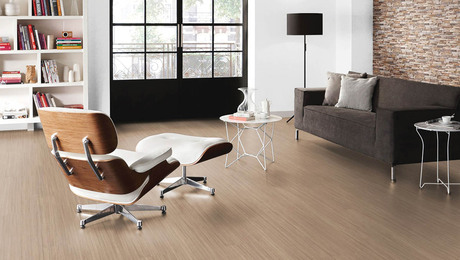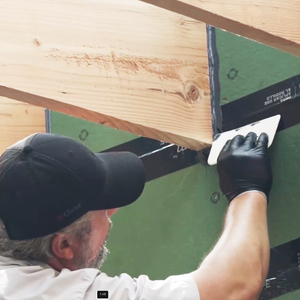As part of my unending residing job I’m also rebuilding partsof a veranda and front porch. I’m using PT lumber (SPF), and due to necessity (existing conditions), I have to attach the handrail posts to the rim joists. I’ve seen it done both ways, but am wondering what people think about the wisdom/not of notching the 4×4 posts so that half sits on the top of the porch. The posts on the veranda will also support a lightweight (polycarbonate) roof/sunscreen (only about 4′ extended from the house). While notching the post would seem to provide a modicum of better support, I’ve learned the hard way that PT lumber will rot if given the chance, and notching into the core of the post seems to me to be inviting water infiltration and rot. Is it acceptable to just lag-bolt the posts as-is to the rim joist without notching?
Discussion Forum
Discussion Forum
Up Next
Video Shorts
Featured Story

The recipe for linoleum hasn't changed much in nearly 170 years, yet it's still one of the greenest floors money can buy.
Featured Video
Video: Build a Fireplace, Brick by BrickHighlights
"I have learned so much thanks to the searchable articles on the FHB website. I can confidently say that I expect to be a life-long subscriber." - M.K.

















Replies
Hokuto
I've done it about as many ways as seemed possible at the time.
While notching does provide pretty good support and self trimming, it also might allow a split to start at the notch. Therefore in a guardrail situation, probably not a good idea. You also bring up the exposure of the not so treated portion of the post.
If not cutting into the post I try to place it in a corner at the rim and joist, allowing me to bolt to both and thus limiting movement in two directions. The connection to either is also going to depend on the connections of the frame you're going to.
If Bob the deck builder could see this I'm sure he'd offer better opinions on these types of fastening. ProDek.
Do not notch
I would not notch a 4x4. It is against code here.You can notch a 6x6 but not a 4x4. here is a picture of pressure blocking 6x6 bench supports in front of a railing.
In your case I would pressure block then through bolt the roof support post.
Of course, part of the issue is the "look" you want, and where the post needs to be relative to the rim joist or other members. I'd say that if those factors don't figure in it's better to not notch, from a strength standpoint. Without the notch you lose a little bit of down thrust resistance and "gain" a bit of side-to-side wiggle, but the "leaning against the handrail" strength is significantly improved.
I prefer a notch with the shoulder on the joist, decking cut to fit. Can't say I've seen pressure treated rot from a cut but we don't have the brown treated, just the green and it's completely through the lumber. The notch doesn't have to be much, 3/4" is plenty. This takes the shear force off the bolts if carrying a load, adds side movement stability and a shallow notch doesn't degrade the strength significantly, especially if the post is on the inside of the rim joists, notch facing out.
PS. carriage bolts with nuts and washers, not lag bolts.
Sorry for the late reply!
My apologies, and gratitude, to those who replied. I've been working on other things the last few days, but I've kept your ideas in mind. Let me add some information. The veranda is 580 cm long, cantilevered 95cm from the house wall on the 2x10s forming the 2nd storey floor joists. The veranda floor has an underlayment of plywood, covered with a thick industrial rubber sheet, on top of which I installed tile. That much has held up well, but it also means that I can't cut into the deck surface to install posts inside the rim joist. The posts have to go on the outside, end of story.
Due to lack of flashing and other water countermeasures, I discovered dry rot in the two joists forming the ends of the veranda, as well as in several places in the rim joist attached to the floor joists. So I sistered in new PT joist material at the veranda ends, and replaced the rim joist (also with PT). When replacing the rim joist I also added Simpson framing anchors to each joist for a bit of additional support to the rim joist.
>>Calvin: "If not cutting into the post I try to place it in a corner at the rim and joist, allowing me to bolt to both and thus limiting movement in two directions. The connection to either is also going to depend on the connections of the frame you're going to."
Basically, my only rational option is to install the posts on the outside of the rim joist, so I can't bolt to both joists. I've added additional 2x10 backing material to the rim joist in locations where the posts will be installed, so I hope that adds a modicum of stiffening. In fact, in the original installation, the posts were bolted outside to the single layer of 2x10 rim joist, and they seemed to hold up well for 15 years, so I think this next installation will be even stronger.
>>Prodek: "I would not notch a 4x4. It is against code here.You can notch a 6x6 but not a 4x4. here is a picture of pressure blocking 6x6 bench supports in front of a railing."
Thanks for that. I'd heard that it was against code in some locations, and your reply reinforces my idea of doing without the notching. Unfortunately, I can't use pressure blocking per your photo, since the posts must go outside the rim joist (see above explanation). I'm planning on using three 12mm SS bolts per post; the upper ends will be linked to the house via rafters for the polycarbonate sunshade, so there should be no danger of in-out movement.
>>DanH: "Without the notch you lose a little bit of down thrust resistance and "gain" a bit of side-to-side wiggle, but the "leaning against the handrail" strength is significantly improved."
It is the downward thrust resistance that I'm mostly concerned about, since there will be the (slight) extra weight of the polycarbonate roof on the posts. But as I said above, the rafters (2x3) will tie the tops of the posts to the house, so there should be no in-out ("leaning against the handrail" ) strength issue, SFAICS.
>>Hammer1: "
I prefer a notch with the shoulder on the joist, decking cut to fit. Can't say I've seen pressure treated rot from a cut but we don't have the brown treated, just the green and it's completely through the lumber.
The green just means it has lots of copper in it; we have green ACQ treated lumber here, and I don't think it goes anywhere near all the way through (based on observation of end cuts, at least)
The notch doesn't have to be much, 3/4" is plenty. This takes the shear force off the bolts if carrying a load, adds side movement stability and a shallow notch doesn't degrade the strength significantly, especially if the post is on the inside of the rim joists, notch facing out.
I agree with the shear force issue, (see my comments above), although as I mentioned, it's impossible to put the posts on the inside in this case.
PS. carriage bolts with nuts and washers, not lag bolts.
I assume you meant lag screws here?
Overall, I'm basically tending toward no-notch, with three 12mm SS bolts for support into the 2x10 rim joist.
Thanks again. I'll try to post some photos of the joist situation later.
Later edit:
Here's the original veranda, 580 cm long (siding on the house is LP "Inner Seal" OSB. Dark spots indicate rotting; I've now replaced it all with Hardyplank Colorplus; photo taken from the north side:
http://s27.photobucket.com/albums/c197/Peregrinor/ww/2010_housework/P3180831w1.jpg
The veranda's rim joist after removal of the rotting siding and the deck stairway; dry rot on both east (left) and west (right) ends--as well as in the middle:
http://s27.photobucket.com/albums/c197/Peregrinor/ww/2010_housework/P4151947crw1.jpg
The easternmost joist, after I removed the deck stairway; dry rot has infected more than half of the exposed joist.
http://s27.photobucket.com/albums/c197/Peregrinor/ww/2010_housework/PC106748crw1.jpg
http://s27.photobucket.com/albums/c197/Peregrinor/ww/2010_housework/PC096724crw1.jpg
Joist on the west end; dry rot a similar issue here:
http://s27.photobucket.com/albums/c197/Peregrinor/ww/2010_housework/PC106735crw1.jpg
West end joist, with newly sistered part; new rim joist on left:
http://s27.photobucket.com/albums/c197/Peregrinor/ww/2010_housework/P4217778crw1.jpg
East end joist, with newly sistered part; new rim joist on right; since a deck stairway will be attached here, I've also added two blocking sections behind the joist, linking it to the second joist.:
http://s27.photobucket.com/albums/c197/Peregrinor/ww/2010_housework/P4217773crw1.jpg
Ho.......
Basically, my only rational option is to install the posts on the outside of the rim joist.
I"d consider a "kick bd." at the bottom, close to the finished deck floor. This will keep your/kids/anyone's foot from going off the deck because of the posts being to the outside.
If, as you say, there will be a "roof" on the posts, and if it will tie back to the house, you could simply sit the posts on top of the deck(ideally on post stand-offs), directly over the rim joist. You would need to cross-brace the roof structure a little more securely than otherwise, and you'd lose a few inches of effective deck width, but that would be it.
Cal and Dan,
thanks again. Calvin, there's already a rim on the edge of the veranda, formed by a 2x4 under the rubber sheeting, so no problem with errant feet. Dan, the idea of putting the posts on the deck edge (the aforementioned 2x4) is intriguing, but I think the bolts-thru-the-outside solution is simpler in terms of stabilizing; and as you note, I would lose 4 inches of the veranda space. Interesting option, tho.
other hardware
Instead of just the carriage bolts on that 2nd floor deck, you might consider using these:
http://www.strongtie.com/products/connectors/DTT2.asp